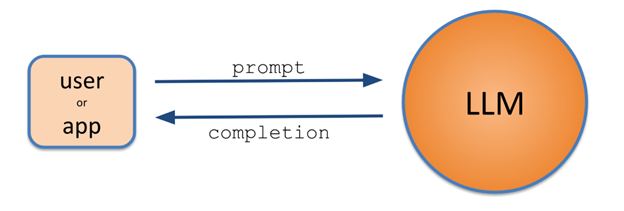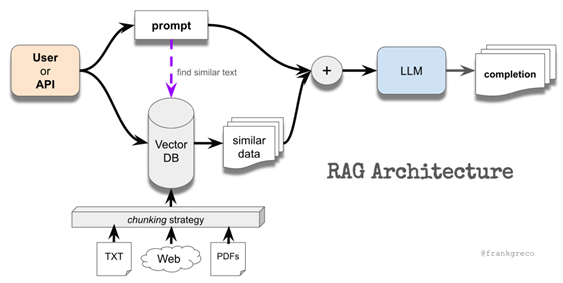
April 2024
Upcoming events by this speaker:
May 13-14, 2024 Online live streaming:
Introduction to Generative AI for Java Developers
Generative AI and Enterprise Java Developers
Effective Communication with Generative AI
We certainly know that Generative AI is a groundbreaking field that has evolved rapidly, offering incredible potential for creativity and problem-solving. Communicating effectively with these models is critical and involves mastering the art of prompt engineering.
At the core of interacting with generative AI is the concept of prompts and completions. A prompt is the input that is provided to the model, guiding it to generate relevant and coherent outputs. Those outputs returning from the LLM are called completions, i.e., the LLM effectively says, “I will use your prompt starting point and complete a string of words based on the most probable ones that I have learned”.

Understanding the relationship between prompts and completions is key to getting an LLM to generate the desired result. Crafting prompts with precision is vital for obtaining desired and meaningful completions.
Importance of Effective Prompts
The quality of prompts significantly influences the output of generative AI. Well-crafted prompts lead to more accurate and contextually relevant responses. Clear and specific prompts enhance the model’s understanding of the user’s intent, resulting in more satisfactory outcomes.
- Clarity and Specificity: Clearly articulate your request. Ambiguous prompts may lead to unexpected or undesired results. Specify the format or type of response you seek.
- Contextual Information: Provide relevant context within your prompt. This helps the model understand the nuances and generate responses that align with your expectations.
- Length and Detail: Experiment with the length of the prompts. Sometimes, concise prompts work best, while other situations may require more detailed and lengthy instructions. Test and iterate to find the optimal balance.
OpenAI and GenAI Services
There are several very large companies offering GenAI services, such as OpenAI, Google, Anthropic, Cohere, Meta, Hugging Face, etc. Many of the fundamental services from these companies are similar. Thanks to the popularity of its chatbot application “ChatGPT”, OpenAI and its service offerings are certainly among the leaders in the industry.
Two prominent platforms for interacting with OpenAI’s generative models are ChatGPT and Playground. Both use the OpenAI stateless APIs. ChatGPT is a chat application that maintains a history of the conversation with the user to maintain a sense of context, which improves the model’s response. ChatGPT is designed for more interactive and dynamic conversations, making it suitable for a wide range of applications, including code generation, debugging, explanations, unit test generation, and general ideation. On the other hand, Playground provides a more controlled environment for experimenting with model inputs and observing outputs. You can take the lessons learned from Playground experiments and use them in your Java software.
Mastering prompt engineering is the gateway to unlocking the full potential of generative AI. By understanding the nuances of prompts, appreciating the impact of well-crafted inputs, and exploring practical examples, users can harness the capabilities of these powerful models to enhance creativity, problem-solving, and interactive experiences.
Crafting a Private Chatbot Architecture in Java
Building a private chatbot using Java-centric tools can be rewarding, leveraging the power of Generative AI to create intelligent and interactive conversational agents. We’ll focus on OpenAI’s API and services, but all the language models from the various companies and open-source versions are functionally similar.
OpenAI’s ChatGPT, powered by the GPT architecture, offers a versatile platform for natural language processing. The Playground provides developers with a testing ground to experiment with the model’s capabilities. Through OpenAI’s REST APIs, Java developers can seamlessly integrate ChatGPT into their applications.
However, ChatGPT is trained on general web information and, typically, has no knowledge of your own documentation and other resources. While you can fine-tune the existing OpenAI language models, it typically requires data science expertise, carefully curated data sets, and a significant amount of computing resources and expense.
Another cost-effective and popular technique to get an LLM to understand your own documentation set is called Retrieval Augmented Generation or RAG. This surprisingly accurate technique was developed by Facebook AI Research in 2020. RAG techniques enhance the chatbot’s responses by combining generative and retrieval-based approaches. Utilizing Java-centric tools, developers can implement RAG to improve the relevance and coherence of the chatbot’s responses. Understanding the intricacies of RAG ensures optimal utilization of OpenAI’s powerful language models.
Crafting a private chatbot architecture in Java involves integrating OpenAI’s ChatGPT with Java-centric tools and implementing RAG techniques. This is done by navigating vector databases and word-similarity algorithms (embeddings), which are crucial for enhancing retrieval capabilities. By following this pattern as a guide and utilizing Java’s robust ecosystem, developers can build and deploy intelligent chatbots that understand local and private information, such as corporate resources.

Responsible AI
Since AI/ML is an extremely powerful tool, Java developers venturing into this domain must prioritize ethics, security, privacy, and responsible AI practices. These considerations go beyond coding proficiency and are crucial for ensuring the responsible deployment of AI technologies.
Responsible AI development involves addressing the broader societal impact of AI applications. Java developers should be mindful of the potential consequences of their creations on employment, social structures, and the environment. Striking a balance between innovation and responsibility ensures that AI contributes positively to society without causing harm or exacerbating existing inequalities.
Java developers entering the field of AI should also be cognizant of bias and fairness issues. AI models can inadvertently perpetuate biases present in training data. Developers must actively work to identify and mitigate biases, employing techniques such as fairness-aware machine learning and continuous monitoring to rectify any unintended disparities.
Ethics, security, privacy, and responsible AI practices are integral components of a Java developer’s skill set when venturing into the world of AI. Beyond mastering algorithms and coding, developers must champion ethical considerations, implement robust security measures, prioritize privacy, and ensure responsible AI deployment. By embracing these principles, Java developers contribute to building AI systems that are not only technically proficient but also ethically sound and socially responsible.
Java Developers Must Understand AI/ML
AI/ML systems are a long term trend not only for the IT industry but for everyone. It will have an effect on people, companies, enterprises, countries, economies, and civilization. Used responsibly, this technology will provide many benefits. Java developers must understand how to properly use AI/ML in their everyday workflow. Java developers without this knowledge will be at a significant disadvantage.